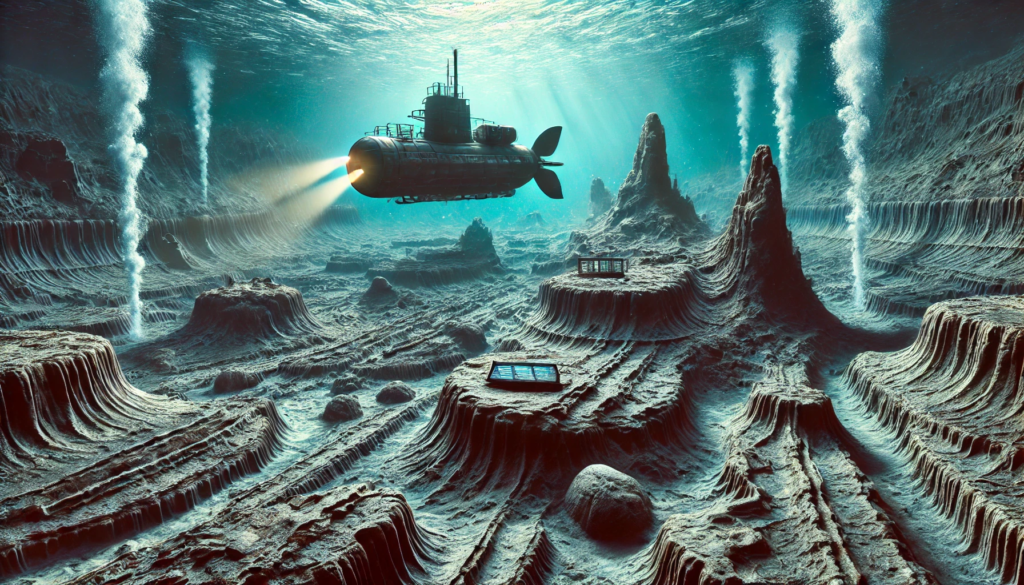
Scientists have recently made a remarkable discovery deep in the Pacific Ocean, uncovering remnants of an ancient seafloor that sank around 250 million years ago. This finding could challenge existing theories about Earth’s internal structure and provide new insights into the planet’s complex geological history. The discovery is not only groundbreaking for the field of geology but also raises several questions about how Earth’s interior and surface interact over time.
New Insights into Earth’s History
For decades, scientists have been searching for evidence of submerged ancient seafloors. The newly uncovered remnants of this seafloor provide crucial data for understanding our planet’s past. Researchers believe the seafloor was part of a massive tectonic plate that sank deep into Earth’s mantle, providing a rare glimpse into Earth’s interior processes. This discovery offers new perspectives on how tectonic plates behave once they are pulled into the depths of the ocean.
The discovery of these ancient seafloor remnants is particularly significant because it can shed light on the processes that have shaped Earth’s surface for millions of years. The newly discovered seafloor is believed to be a part of what was once a much larger tectonic plate that sunk into the Earth’s interior, far from the surface where most geological studies occur.
Implications for Current Theories
Jingchuan Wang, a researcher from the University of Maryland, explained the importance of this finding. According to Wang, the discovery could challenge long-standing theories about Earth’s deep interior and how it influences surface-level phenomena. “Our findings raise questions about how the deep Earth influences surface phenomena,” he noted.
Wang and his team discovered a 19-kilometer-thick section of the Earth’s mantle transition zone that spans about 1,900 kilometers. This zone sits between the upper and lower mantle, and Wang described this discovery as “the fossilized trace of an ancient seafloor.” He and his team believe that understanding this ancient remnant could reveal new details about Earth’s past and help explain present-day geological activity, such as seismic movements and volcanic activity.
This discovery suggests that materials within Earth’s deep interior move more slowly than previously thought. As a result, the ancient remnants of tectonic plates may be preserved for much longer periods than scientists once believed. This finding could also have implications for how we understand the lifecycle of tectonic plates, particularly those that submerge into Earth’s mantle through the process of subduction.

Understanding Submerged Features
One of the significant challenges in studying ancient seafloor remnants is that they often leave little trace on the Earth’s surface. Subducted oceanic plates are usually consumed by Earth’s interior, leaving behind almost no evidence of their existence. Volcanic activity, earthquakes, and other surface phenomena typically offer the only indirect clues about these hidden features.
However, Wang’s discovery highlights that not all plates are entirely consumed. Some material may remain intact, buried deep within Earth’s mantle. This finding opens up possibilities for uncovering other ancient tectonic features, which could transform our understanding of Earth’s interior dynamics.
Wang pointed out that the study of this ancient seafloor may also help explain why certain seismic activities occur. He emphasized that understanding the behavior of submerged oceanic plates is crucial to interpreting surface events like earthquakes. This knowledge could potentially lead to better predictions of future seismic events, particularly in regions prone to tectonic movement.
Connection to Seismic Activity
One of the most intriguing aspects of this discovery is its potential link to the Pacific Large Low Shear Velocity Province (LLSVP). The LLSVP is an area of the Earth’s mantle characterized by slower seismic wave movements, and researchers have long been trying to determine its origins. Wang’s team believes that the ancient seafloor they discovered could be connected to this region, disrupting the LLSVP and altering its properties.
The researchers suggest that the ancient seafloor may have interrupted the flow of materials in the mantle, leading to the slower seismic wave speeds observed in the LLSVP. The team also thinks these remnants could be related to the Phoenix Plate, a tectonic plate that once transported cooler materials from the ocean floor into the Earth’s mantle.
If this connection is proven, it could offer a new explanation for why certain regions experience slower seismic activity. It could also provide insight into the broader dynamics of Earth’s mantle, including how different materials interact deep beneath the surface.
Future Research Goals
The discovery of the ancient seafloor has opened new avenues for research, and Wang’s team plans to expand their studies to other areas of the Pacific Ocean. Their goal is to map ancient subduction and uplift zones, which could reveal more about how Earth’s interior has evolved over millions of years.
Wang believes that many more ancient structures await discovery deep within Earth’s mantle. “We believe many ancient structures await discovery in Earth’s depths. Each could provide new insights into our planet’s complex history,” Wang said. The team hopes that further research will not only uncover more ancient tectonic remnants but also deepen our understanding of Earth’s internal processes and how they influence surface-level phenomena like earthquakes and volcanic eruptions.
This discovery also highlights the importance of continued research into Earth’s deep interior. By studying ancient tectonic plates and their remnants, scientists hope to piece together a more complete picture of Earth’s geological history, ultimately leading to a better understanding of how our planet functions.
Conclusion
The discovery of remnants from an ancient seafloor deep within the Pacific Ocean has significant implications for our understanding of Earth’s geological history. This finding challenges existing theories about how tectonic plates behave once they are submerged into Earth’s mantle and raises new questions about how the deep Earth influences surface phenomena like earthquakes and volcanic activity.
With more research planned for the future, scientists hope to uncover even more ancient structures that could provide crucial insights into Earth’s past. These discoveries could change the way we view our planet’s internal processes and deepen our knowledge of the complex forces that shape Earth’s surface.
Source: NTV






